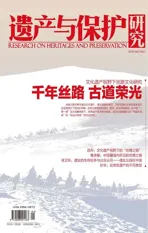突出特色 打造遗产研究精品刊物
——写在《遗产与保护研究》杂志创刊之际
2016-02-02古榕
突出特色打造遗产研究精品刊物
——写在《遗产与保护研究》杂志创刊之际
《遗产与保护研究》杂志社各位同仁:
值此寒风凛冽的腊月时节,由卓众出版集团出版的《遗产与保护研究》杂志创刊了!在此,我谨代表联合国教科文组织并以我个人的名义向贵刊表示最热烈的祝贺,向编辑部全体工作人员致以最诚挚的问候。
在人类漫长的发展过程中,遗产犹如一部笔记,在时光雕刻下记载着人类文明。中华民族文化博大精深,物宝天华,神奇的造物主在中国土地上创造出自然遗产,勤劳的祖先为后人留下灿烂丰富的文化遗产。遗产不仅是文明的佐证,更是文化的载体。
联合国教科文组织于1972年倡导缔结《保护世界文化和自然遗产公约》,将具有杰出和普遍价值的文化古迹与自然景观,作为全人类的共同财产加以保护管理。中国于1985年正式加入《公约》,1987年开始遗产申报工作,同年12月在第11届联合国教科文组织世界遗产委员会上,首次将北京故宫博物院、周口店北京人遗址、泰山、长城、秦始皇陵(含兵马俑坑)、敦煌莫高窟六处文化与自然遗产列入《世界遗产名录》。在30年时间里,中国世界遗产事业在申报组织、保护管理、制度创新、能力建设、旅游发展、社会服务等方面均取得了巨大成就。中国现已拥有48项世界遗产,其中包括34处世界文化遗产(包括4处文化景观)、10处世界自然遗产、4项世界自然与文化双重遗产。目前,中国还有54处遗产地,现已列入世界遗产预备清单。
在刚刚过去的2015年,联合国教科文组织驻华代表处主办了联合国教科文组织成立70周年暨中国加入《世界遗产公约》30周年成果发布会。我们发布的成果包括:联合国教科文组织世界遗产资源手册(共4册)的中文版,包括《世界遗产灾害风险管理》《世界自然遗产管理》《世界遗产地申报筹备》《世界文化遗产管理》,以及《中国世界自然遗产事业发展公报 (1985—2015)》《中国文化遗产30年》《联合国教科文组织—梅赛德斯—奔驰星愿基金—中国世界遗产地保护和管理项目成果报告书(2007—2015)》。这些成果是中国遗产事业30年蓬勃发展的一个缩影,对未来的实践有启发和指导意义。
目前,中国已初步建立了具有中国特色的世界遗产保护体制与管理模式,在遗产保护和可持续发展方面积累了很多经验。这是长期以来政府、遗产地、企业、传承人等社会各方面共同努力保护的结果。但同时,也应看到中国的遗产保护工作仍然存在不少问题,如有些区域遗产保护管理混乱、专业人才匮乏、能力建设有待提升等。因此,加强遗产保护与研究,提供与时俱进的指导意见和对策,使遗产项目获得可持续的发展意义重大。
我欣喜地看到,时值中国的世界遗产事业的而立之年,《遗产与保护研究》这一崭新的生命体的问世,无疑为中国乃至世界的遗产保护事业补充了新鲜的血液。杂志致力于在遗产领域深耕细作,为遗产保护相关各界搭建学术思想交流的平台。希望伴随中国乃至世界遗产事业的蓬勃发展,《遗产与保护研究》杂志能够越办越好,为遗产事业健康可持续发展贡献力量!
古榕
联合国教科文组织驻华代表处文化项目官员
Dear Colleagues of Research on Heritage and Preservation:
I am pleased to hear that during this cold winter,Research on Heritage and Preservation magazine was established by Beijing Promotion Publishing,Ltd.On behalf of UNESCO,I would like to extend my sincere congratulations to Promotion Publishing and my best regards to all the staff of the editorial department.
Heritage marks the tracks of human civilization within the broad process of human development.Chinese culture is broad and profound,the Creator created and brought natural heritage on earth,our industrious ancestors have passed on splendid and rich cultural heritage.Heritage is not only evidence of civilization,but also the carrier of culture.
The World Heritage Convention was adopted by UNESCO in 1972.Its aim is to promote cooperation among nations all over the world to protect and manage cultural and natural heritage that is of Outstanding Universal Value for current and future generations.China ratified the Convention in December 1985,and started preparing World Heritage nominations in 1987.During the 11th session of the Committee,held in December 1987,the World Heritage Committee inscribed six Chinese sites on the World Heritage List,including:Imperial Palaces of the Ming and Qing Dynasties in Beijing Mausoleum of the First Qin Emperor,Mogao Caves,Mount Taishan,Peking Man Site at Zhoukoudian,and The Great Wall.During the past 30 years,China has achieved great results in terms of nomination and organization,conservation and management,institutional innovation,capacity building,tourism development and public services at World Heritage sites.Currently there are 48 sites inscribed on the World Heritage List,of which 34 are Cultural sites (including 4 cultural landscape),10 are Natural sites and 4 are Mixed sites;moreover,In addition,54 sites in China are currently on the World Heritage Tentative List.
In November 2015,an Achievement Release Meeting was organized by UNESCO Beijing Office as part of the celebrations for the 70th anniversary of the founding of UNESCO and the 30th anniversary of China′s ratification of the World Heritage Convention.During the meeting,held in the Palace Museum,the Chinese version of the four UNESCO World Heritage Resource Manuals(Managing Disaster Risks for World Heritage;Preparing World Heritage Nominations;Managing Natural Heritage;Managing Cultural Heritage)were officially released and presented for the first time to the public.The Achievement Report of the UNESCO—Mercedes-Benz Project on Conservation and Management of World Heritage Sites in China(2007-2015)was also released,together with the Development Bulletin of China World Heritage’s 30th Anniversary(Natural and Mixed sites).These publications review China’s journey through 30 years of World Heritage history and therefore form an invaluable source of inspiration and guidance for future practices.
Thanks to the precious expertise and experience accumulated in heritage conservation and sustainable development,China has already started to establish a World Heritage conservation system and management model that fits within the Chinese context.The outcomes reflect the collaboration among various stakeholders,including government authorities,World Heritage sites managers,enterprises,and local communities.However,at the same time,many World Heritage sites still lack systematic management practices and expertise to ensure an efficient and sustainable World Heritage protection.Hence,it is necessary to enhance heritage conservation and research to provide guidance and strategies for sustainable development of heritage conservation.
I am extremely delighted to see that,at the time of the thirtieth anniversary of China′s World Heritage mission,Research on Heritage and Preservation is being published.I believe that this important magazine will inject new energy into China’s World Heritage mission.The magazine will be devoted to setting up a stage of academic communication in China and abroad.Lastly,I wish Research on Heritage and Preservation every success in this noble task in enhancing the World Heritage mission for sustainable development.
Himalchuli Gurung
Programme Specialist for Culture,UNESCO Beijing Office
Outstanding Characteristics:EstablishingHigh-levelHeritageResearchPublications——Congratulatory article for the first issue of the Research Heritage and Preservation
